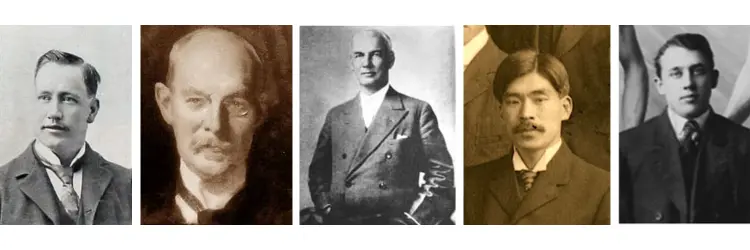Pioneers of Volleyball

Pioneers of Volleyball: Key Figures Who Shaped the Sport
Volleyball, a sport enjoyed by millions worldwide, has a fascinating history that traces back to the late 19th century. Like many modern games, its evolution was shaped by innovative individuals who laid the foundation for what volleyball is today.
From the sport’s creation to its growth and international recognition, these key figures played pivotal roles in shaping volleyball’s development. This article explores the lives, contributions and lasting legacies of the pioneers who helped establish and popularize volleyball.
William G. Morgan: The Inventor of Volleyball
Early Life and Vision
William G. Morgan, the most prominent figure in volleyball’s early history, was born on January 23, 1870, in Lockport, New York. He attended the International YMCA Training School (now Springfield College) in Massachusetts, where he befriended James Naismith, the inventor of basketball.
Inspired by Naismith’s invention, Morgan sought to create a new game that would be less physically demanding and more suitable for older participants or those who found basketball too strenuous.
The Birth of “Mintonette”
In 1895, while working as the Physical Director at the YMCA in Holyoke, Massachusetts, Morgan introduced a game he initially called “Mintonette.” The game combined elements from basketball, baseball, tennis and handball. It was played indoors, using a net set at 6 feet 6 inches and the objective was to volley the ball over the net, trying to prevent it from touching the ground.
Morgan’s creation emphasized strategy and skill rather than brute athleticism. The game quickly attracted attention for its accessibility, requiring minimal equipment and adaptable to various age groups and fitness levels.
The Name Change
During an exhibition game in 1896 at the YMCA in Springfield, Dr. Alfred Halstead, a spectator and professor, observed that the game primarily consisted of volleying the ball back and forth. He suggested renaming it to “volleyball,” a term that aptly captured the essence of the sport. The name stuck and the game began to spread rapidly through YMCA networks.
Morgan’s vision laid the groundwork for volleyball to become a globally recognized sport, with his emphasis on inclusivity and strategy helping it appeal to a wide audience.
Alfred T. Halstead: The Promoter of Volleyball
Naming the Game
Alfred T. Halstead, a professor at Springfield College, played a critical role in popularizing volleyball by giving it a more fitting name. His suggestion to call the game “volleyball” was instrumental in marketing the sport, making it more appealing and easier to understand for the public.
Spreading the Sport
Halstead didn’t stop at naming the game; he helped to refine its rules and promote it within YMCA networks. His efforts ensured that volleyball was adopted in more YMCAs across the United States, leading to the sport’s rapid growth. By simplifying and formalizing the game’s rules, Halstead helped set the stage for volleyball’s future as a competitive sport.
Dr. George J. Fisher: The Standardizer of Rules
Early Involvement with Volleyball
Dr. George J. Fisher, an influential YMCA official, played a significant role in developing volleyball by helping to standardize its rules. He recognized the potential of volleyball to become a major recreational and competitive sport and worked to create a uniform set of guidelines for gameplay.
Formation of the National Rules Committee
In 1916, Dr. Fisher chaired the National YMCA Physical Education Committee, which was tasked with updating and standardizing the rules of volleyball. His work ensured consistency in how the game was played across different regions, which was critical for volleyball’s transition from a local pastime to an organized sport.
Promoting Volleyball Worldwide
Dr. Fisher’s commitment to volleyball extended beyond the United States. He promoted the sport internationally, particularly through YMCA networks in Europe and Asia. His efforts contributed to volleyball being played in schools, community centers and military institutions worldwide, significantly expanding its reach.
Hyozo Omori and Franklin Brown: Introducing Volleyball to Asia
Spreading Volleyball to Japan
In 1908, Hyozo Omori, a Japanese educator and YMCA secretary, introduced volleyball to Japan after studying in the United States. Omori was instrumental in teaching the fundamentals of the game to Japanese students and teachers, helping to embed volleyball in Japan’s educational system.
Franklin Brown’s Role in the Philippines
Around the same time, Franklin Brown, an American YMCA worker, brought volleyball to the Philippines in 1910. Filipino players quickly embraced the game and developed innovative techniques, such as the “bomba” (spike) and the set-and-spike play. These techniques later influenced the evolution of the sport globally.
The introduction of volleyball to Asia by Omori and Brown laid the foundation for the region’s dominance in international volleyball competitions.
Elwood S. Brown: The International Promoter
Promoting Volleyball Through Sports Meets
Elwood S. Brown, another prominent figure in the YMCA, is credited with organizing the first Far Eastern Championship Games in 1913. These multi-sport competitions included volleyball, which further popularized the game in Asia. Brown’s promotion of volleyball in the Philippines, China and other Asian nations helped solidify its status as a key recreational activity.
Legacy of Global Expansion
Brown’s efforts helped turn volleyball into a global sport long before it became an Olympic event. His vision of sports as a unifying activity fostered greater cultural exchange and cooperation through volleyball.
Paul Libaud: The Architect of International Volleyball Governance
Founding the Fédération Internationale de Volleyball (FIVB)
Paul Libaud, a French sports official, played a pivotal role in the formal organization of international volleyball. In 1947, he helped found the Fédération Internationale de Volleyball (FIVB) in Paris, serving as its first president until 1984.
The FIVB established standardized international rules and organized the first Men’s World Championship in 1949 and the first Women’s World Championship in 1952.
Volleyball in the Olympics
Under Libaud’s leadership, volleyball was introduced to the Olympic Games in Tokyo in 1964. This milestone cemented volleyball’s status as a premier international sport and increased its visibility worldwide. Libaud’s organizational skills and vision for the sport laid the foundation for the professional leagues and international tournaments that exist today.
The Legacy of Volleyball’s Pioneers
The development of volleyball was not the work of a single individual but the combined efforts of visionary leaders who recognized the sport’s potential. William G. Morgan’s initial invention set the stage, while Alfred Halstead, Dr. George J. Fisher, Hyozo Omori, Franklin Brown, Elwood S. Brown and Paul Libaud each contributed to the sport’s growth, refinement and international appeal.
Their contributions transformed volleyball from a simple YMCA game to a global phenomenon enjoyed by millions. Today, the sport continues to evolve, but the foundational work of these pioneers remains a testament to the power of innovation, cooperation and passion for physical education.


